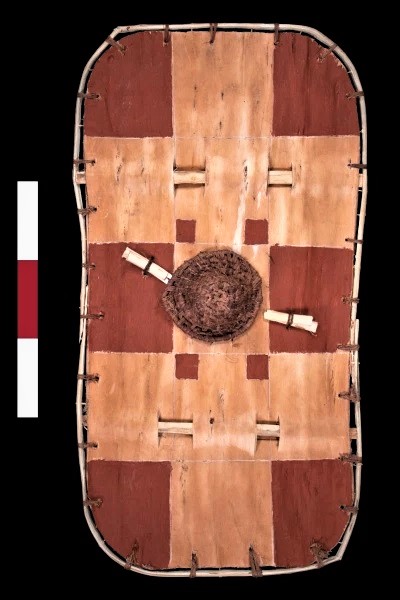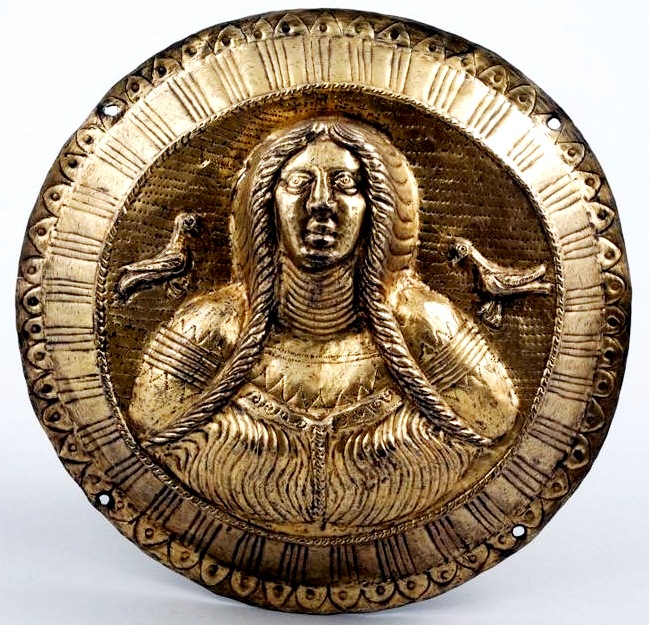
The Celtic Bark shield discovered at Everards Meadows, south of Leicester (England) dates to between 395 and 255 BC


Experimental Reconstruction
RE

The Celtic Bark shield discovered at Everards Meadows, south of Leicester (England) dates to between 395 and 255 BC


Experimental Reconstruction
RE
A fascinating series of inscriptions discovered in the ‘Roman’ cemetery at Poetovio in Pannonia (Ptuj, e. Slovenia) have provided sensational evidence on Celtic society and religion during the Roman period in this part of Europe, and the use of a Celto-Etruscan script on the Balkans.
Among the graffiti on ceramic vessels found at the western cemetery at Poetovio, a number of Celtic inscriptions have been identified which may be divided into 2 main groups:
The first group of inscriptions includes a number of vessels, which date from the 1st / 3rd c. AD, inscribed with Celtic names. Example of such include the names TOCIES – written on a jug dating to the late 1st/ 2nd c., and M. BITTIV, inscribed on the body of another jug, Bittius/Bitus being one of the most common Celtic personal names, recorded in numerous inscriptions across Europe from the British Isles to Galatia (Egri 2007; see also mac Gonagle 2012).
The TOCIES and BITTIV inscriptions
(after Egri 2007)
While the aforementioned inscriptions give us valuable information on the ethnic composition of this region during the period, most interesting from the Poetovio site are two religious inscriptions, which provide fascinating evidence on Celtic (Romano-Celtic) religion and the use of a Celto-Etruscan script in this region.
THE NUTRICES
The first of these inscriptions – MATERIA – (written on a jar in cursive letters) is particularly interesting because it is further evidence of a phenomenon already identified by archaeological data from the area – the worship of the Celtic Mother Goddess, in the form of the Nursing Matres or Nutrices.
(after Bόnis 1942)
The Nursing Matres or Nutrices was a cult widespread in the Celtic world, and particularly significant around Poetovio where 2 sanctuaries and numerous depictions, often with inscriptions, have been discovered.

Five statuettes in white terracotta of nursing Matres discovered in a well in Auxerre (Yonne).
(Deyts, 1998, n° 30, p. 68)
At Poetovio the Nutrices are always venerated in the plural form, often portrayed as 3 women, one of them holding and breastfeeding a baby. A significant number of dedicators to the Nutrices at the site also have Celtic names indicating that the cult of the Nursing Matres were brought here by a Celtic group which had settled the region with other Celtic tribes when they occupied the later Regnum Noricum (Šašel Kos 1999).
“Alphabet of the Druids”
The most sensational Celtic inscription to be found at Poetovio is undoubtedly that found on a ceramic beaker at the site. Dated to the 2nd/3rd c. AD, and written in a Celto-Etruscan script, the inscription reads:
ARTEBUDZ BROGDU
which has been translated as ‘Artebudz for Brogdos’. Both names are Celtic, and the vessel was a votive offering to Brogdos – a deity guarding the border between the world of the living and the after-world (Eichner et al 1994:137; Egri 2007).
The Brogdos Inscription
(after Istenič 2000)
The use of scripts based on the Etruscan alphabet by the Celtic tribes is well documented in other parts of Europe, with recent discoveries providing important new information which indicates that the use of such was much more extensive than previously thought.
Fragment of bone with inscription to the Thunder God Taranis in a Celto-Etruscan script, from Tesero di Sottopendonda (Trente) Italy (4/3 c. BC)

Inscribed glass bead from a Celtic burial at Münsingen-Rain (Bern), Switzerland. The inscription (in Etruscan characters from right to left) is a proper name – Anthine.
(3-2 c. BC)

7 glass beads from a Celtic sanctuary at Mathay-Mandeure (Doubs) in eastern France. Discovered in the 19th century, it has only recently been established that the beads are engraved with inscriptions in a Celto-Etruscan (Lepontic / Insubro-Lepontic) script. A growing number of Celtic artifacts bearing inscriptions in a similar script, apparently of a religious nature, have been discovered at a number of Celtic sites across Europe.
(2/1 c. BC)
Recorded in other parts of Europe, the use of such a Celtic-Etruscan script on the Balkans has also been known from a series of pre-Roman inscriptions discovered prior to the First World War, in the 1950’s and a handful of recent publications from sites such as Grad near Reka (a cremation urn), the situla fragment from the site in Posočje, as well as the bronze plaque fragment from Gradič above Kobarid (Turk et al 2009), and on a number of Celtic coins (particularly of the Paeonian model) and other artifacts.
Probably the best known examples are the Negau Inscriptions. Discovered in an orchard at the village of Negau (today Ženjak) in Slovenia, the Negau Hoard consisted of 26 bronze Etruscan helmets, many bearing inscriptions in a Celto-Etruscan script. The helmets are of an Etruscan design from circa 500-450 BC called the Vetulonic or Negau type, which are of bronze with a comb-shaped ridge across the skull, and a protruding rim with a groove right above the rim. However, the inscriptions on the helmets are believed to have been added at a much later date (2nd c. BC), and the deposition has been dated to circa 50 BC – i.e. shortly before the Roman conquest of the area.


The Negau B Helmet and inscription
https://balkancelts.wordpress.com/2014/03/14/the-negau-inscriptions/

Silver votive plaque from Vrh Gradu (Šentviška Gora), eastern Slovenia with Celto-Etruscan inscription (2-1 c. BC)
The Grad (A) and Posočje (B) inscriptions
(After Turk et al 2009)
However, until now all archaeological evidence of the use of this script on the Balkans has been confined to the pre-Roman period. Thus, the significance of the BROGDOS inscription from Poetovio cannot be overstated, as it represents not only a further example of this alphabet, but provides conclusive archaeological evidence that this writing system was still known and used in certain parts of the Balkans throughout the Roman period. It is also interesting to note that in each case the script appears to be used in religious contexts, suggesting that the alphabet was strictly controlled and used only by Celtic priests/druids, while the Greek and Latin alphabets were used for more mundane purposes.
Literature Cited
Bόnis E. (1942) Die kaiserzeitliche Keramik von Pannonien. Dissertationes Pannonicae 2.20. Budapest.
Egri M. (2007) Graffiti on Ceramic Vessels from the Western Cemetery at Poetovio. In: Funerary Offerings and Votive Depositions in Europe’s 1st Millennium AD. Cluj-Napoca 2007. P. 37 – 48.
Eichner H., Istenič J., Lovenjak M. (1994) Ein römerzeitliches Keramikgefäss aus Ptuj (Pettau, Poetovio) in Slowenien mit Inschrift in unekanntem Alphabet und epichorischer (vermutlich kelticher) Sprache. In: Arheološki Vestnik 45, 1994, 131-142.
Istenič J. (2000) Poetovio, the western cemeteries II. Ljubljana.
Mac Gonagle B. (2012) https://www.academia.edu/3292310/The_Thracian_Myth_-_Celtic_Personal_Names_in_Thrace
Šašel Kos (1999) Pre-Roman Divinities of the Eastern Alps and Adriatic – Situla 38, Ljubljana.
Turk P., Božič D., Istenič J., Osmuk N., Šmit Ž. (2009)New Pre-Roman Inscriptions from Western Slovenia : The Archaeological Evidence. In: Protohistoire Européenne II, 2009. Éditions monique mergoil Montagnac. p. 47–64.
Mac Congail

Hа български:
http://celtic-society.com/?p=850
Оригинален текст:
CELTIC TRACES IN EASTERN BULGARIA
(English version):
.

“At one moment she was a broad-eyed, most beautiful queen,
And another time a beaked, white-grey badb”.
(Harleian manuscript 4.22)
The central tenet of Celtic religion was metempsychosis – the transmigration of the soul and its reincarnation after death (Caesar J. De Bello Gallica, Book VI, XIV). This belief is probably best summed up by the Roman poet Lucanus (1st c. AD):
While you, ye Druids, when the war was done,
To mysteries strange and hateful rites returned…
Read Full Article: https://balkancelts.wordpress.com/2013/12/10/catubodua-queen-of-death/
.
UD: April 2019
The Celtic deity Esus (aspirated Hesus) has hitherto been known only from a small number of images and epigraphic material dating from the Roman period and later…
FULL ARTICLE:
https://www.academia.edu/37459609/FACE_OF_THE_LORD_The_Celtic_God_Esus_in_Iron_Age_European_Art
.
“Who can I recite my work to here, but yellow-haired
Coralli, and the other tribes of the barbarous Danube?”
(Ovid, Ex Ponto. Book EIV.II To Cornelius Severus: A Fellow Poet)
Ovid’s unenthusiastic audience during his exile on the Pontus, the Celtic Coralli/Κόραλλοι tribe (Julian C. Histoire de la Gaule I 303 n. 3, Kazarov 1919:67, Domaradski 1984:111, Duridanov 1997 with cited lit.), were one of the barbarian peoples who constituted the unique…
FULL ARTICLE:
https://www.academia.edu/36347100/CORALLI_-_Celtic_Traces_in_Eastern_Bulgaria
.
“…the Bastarnæ, the bravest nation of all”.
(Appianus, Mithridatic Wars 10:69)
The most enigmatic ‘barbarian’ people to appear in southeastern Europe in the late Iron Age are undoubtedly the Bastarnae (Βαστάρναι / Βαστέρναι) tribes.
FULL ARTICLE:
https://balkancelts.wordpress.com/2014/03/26/who-were-the-bastarnae-2/
.
.
UD: October 2018
In order to explore the origin and significance of Samhain, the Celtic “Festival of the Dead”, it is necessary that it be viewed in the context of the wider Celtic belief system, the central tenet of which was metempsychosis…
FULL ARTICLE:
.
The Celtic chariot burial from the Mal Tepe tomb at Mezek in the Haskovo region of southern Bulgaria is one of the most significant Celtic finds from the Balkans, in terms of the artifacts themselves, and the nature and chronology of the burial. However, from the outset the site has also been a prime example of the ugliest aspects of archaeology on the Balkans…
FULL ARTICLE:
.
UD: November 2018
The Roman Limes on the Lower Danube – a sophisticated and highly developed defensive and communication network which bears testimony to the magnificent planning and organizational skills of Imperial Rome.
Or was it?
In fact, recent archaeological research in the Lower Danubian region (Croatia, Serbia, Bulgaria, Romania) clearly indicates that this system was not developed by Rome, but adopted from a previously established Iron Age network…
Full Article:
…